Squash (Cucurbita spp.) is a popular food crop grown in residential and community gardens in Maryland. The term “summer squash” refers to zucchini, yellow squash, and patty pan squash – all harvested and eaten when they are young and tender. “Winter squash” refers to varieties such as Butternut, Hubbard, and Kabocha, which are harvested and eaten when the fruits are mature and have a toughened outer skin and fully developed seeds inside. All types of squashes are vulnerable to similar diseases, pests, and environmental stressors. Gardeners should select varieties that have been bred for improved disease resistance, to improve chances of success.
Use this picture guide (or the table below) to identify the most common problems of squash in Maryland gardens. Follow the links to learn how to manage these problems using integrated pest management and other best practices.

Choanephora fruit rot of squash. Photo: Gerald Holmes, Strawberry Center, Cal Poly San Luis Obispo, Bugwood.org
Symptoms on leaves - spots or discoloration
Powdery mildew
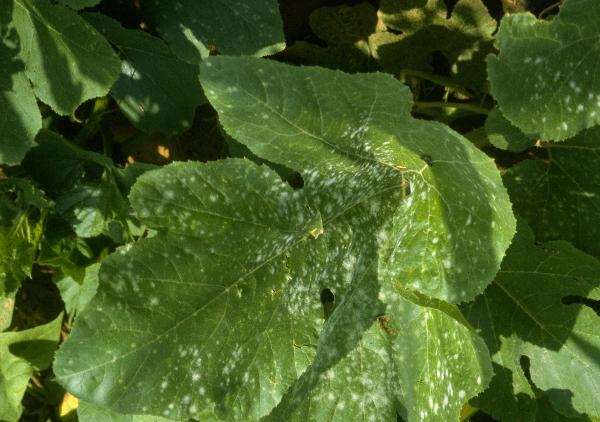
- Symptoms: White powdery spots on leaves; may be on upper and lower surfaces.
- Powdery mildew is a fungal disease favored by warm, humid weather. Symptoms start in mid-summer on older leaves. The disease can spread rapidly, causing whole plants to turn yellow and die. This is a very common disease of summer and winter squashes.
- Plant disease-resistant varieties.
Downy mildew

- Symptoms: Yellow or tan angular spots on leaf surfaces; downy, grayish spots on undersides; starts on older leaves in mid-late summer; lesions grow and coalesce and may cause leaves to yellow and die.
- Downy mildew is caused by a water mold, a fungus-like organism (Pseudoperonospora cubensis).The pathogen moves on air currents and can spread in a garden by infested tools and water. Downy mildew spreads rapidly under humid conditions.
- Plant disease-resistant varieties. There are no curative fungicides for downy mildew once symptoms are present.
Squash bugs
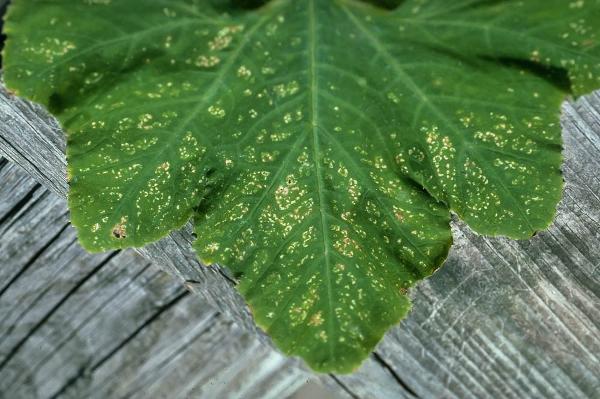
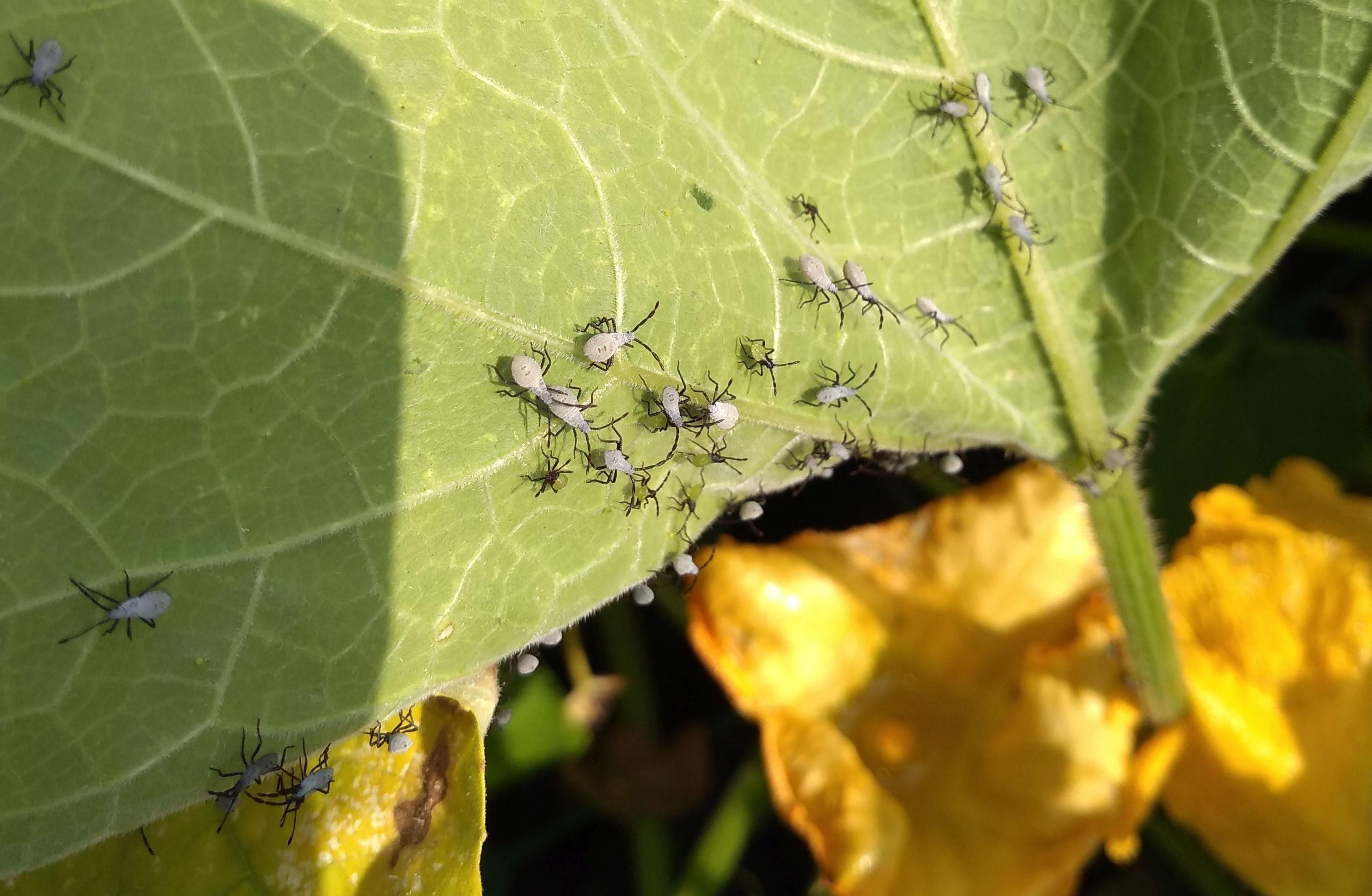
- Symptoms: Small yellow-green or white spots on leaves (called “stippling”); leaves may eventually appear tattered, yellow, or scorched; plant growth and yield can be reduced significantly.
- This symptom is caused by squash bugs (Anasa tristis), which use piercing-sucking mouthparts to sip plant sap. The eggs of this insect are golden and oval-shaped, laid in clusters, most often on the underside of leaves.
- Use row cover over plants until they begin to bloom. Remove egg clusters by hand.
Natural color variation
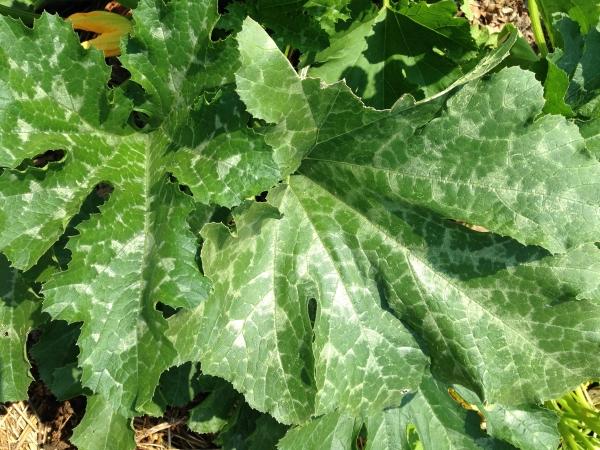
- Symptoms: Smooth gray, white, or silvery angular blotches on the leaf surface; there is no visible powder or fungal residue.
- This is not a disease. This is normal color variation in the leaves of some types of zucchini .
- No action is necessary.
Viruses

- Symptoms: Leaf distortion, elongated or stretched leaves, irregular yellow markings or mosaic patterns on the leaves. Rings, bumps, and/or discoloration may appear on the skin of infected fruits.
- Several different viruses can infect squash plants: squash mosaic virus (SqMV), yellow zucchini mosaic virus (YZMV), and cucumber mosaic virus (CMV), to name a few.
- Viruses are transmitted by insects and can survive in perennial weeds.
- Pull out and dispose of infected plants. Control weeds, aphids, and cucumber beetles.
Symptoms on leaves - wilting
Squash vine borer

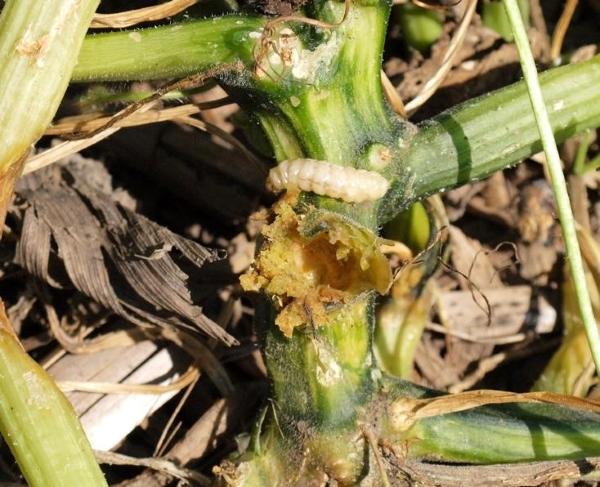
- Symptoms: Leaves and stems wilt; a hole may be present at the base of the plant or along the lowest 8 inches of the main plant stem; small piles of sawdust-like frass (excrement) may be observed where insect larvae bore into the stems, usually near the base of the main stem.
- A native moth, Melittia cucurbitae, is the insect that causes this damage. The adult females lay their eggs on squash plants; when the eggs hatch the young larvae (small, cream-colored caterpillars) feed on the plant tissue inside the stem.
- This is a very common and major pest of squashes.
- Cover plants with row cover or insect mesh when seedlings emerge. Remove during bloom to ensure pollination.
Bacterial wilt

- Symptoms: Leaves and vines wilt; they recover at night but wilt again and eventually die.
- This disease is caused by a bacterial pathogen, Erwinia tracheiphila, which blocks water movement inside the plant. The bacteria is transmitted mostly by striped cucumber beetles feeding on the leaves. The pathogen overwinters in the gut of adult cucumber beetles.
- Cover plants with row cover or insect mesh when seedlings emerge. Remove during bloom to ensure pollination.
Symptoms on leaves and flowers - holes / chewing
Squash beetles
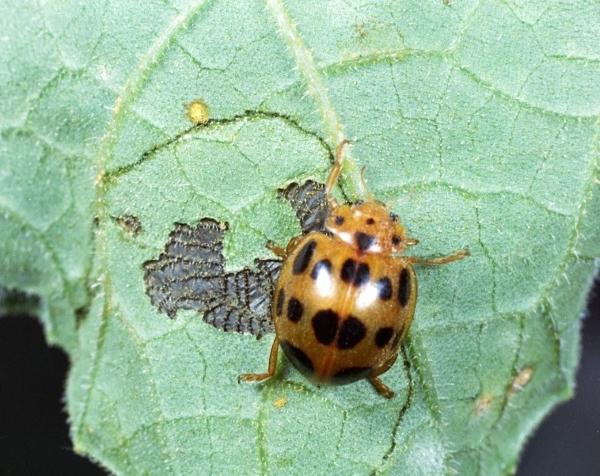
- Symptoms: Chewing damage on the surface of leaves, in between the leaf veins.
- This damage is caused by adult squash beetles (Epilachna borealis), which resemble ladybugs/lady beetles and Mexican bean beetles. They have seven large black spots on each of the wings.
- Use row cover or insect mesh over plants until they begin to bloom.
Cucumber beetles
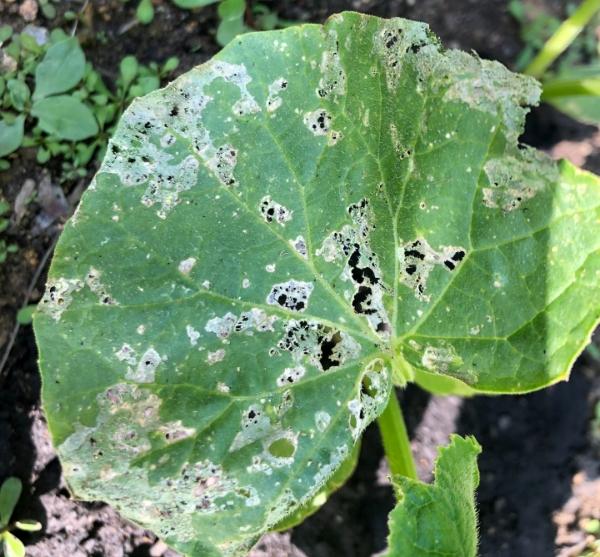
- Symptoms: Chewed leaves, irregular, jagged holes. Similar damage may be found also on flower petals and stems.
- Yellow-green beetles with black stripes or spots may be visible. Adult cucumber beetles are about ¼ inch long.
- Striped cucumber beetles are more likely than spotted cucumber beetles to carry the bacteria that causes bacterial wilt.
- Striped and spotted cucumber beetles both can carry and transmit other plant diseases such as Fusarium wilt and viruses.
- Preventing feeding injury of seedlings and young plants is essential.
Symptoms on squash fruits
Blossom end rot

- Symptoms: A dark blemish appears at the blossom-end of the squash fruit. The blemish may enlarge until the entire bottom of the fruit becomes dark, shrunken, and leathery.
- Blossom end rot is caused by a low level of calcium in the developing fruit. This can occur because of inconsistent watering, low soil calcium levels, and other stress factors.
- Keep plants well-watered and mulched. Avoid high-nitrogen fertilizers.
Choanephora rot
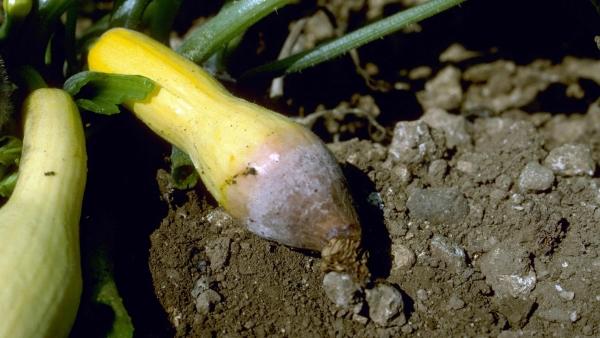
- Symptoms: Fuzzy gray fungal growth first appears on old flowers and then squash fruit; affected fruit parts turn dark brown to black and become fuzzy and mushy.
- Choanephora rot is a disease caused by a fungal pathogen, Choanephora cucurbitarum.
- Warm, humid/wet conditions favor development of this disease.
- Remove blossoms that stick to young fruit, and remove and discard infected blossoms and fruit.
Pollination problems
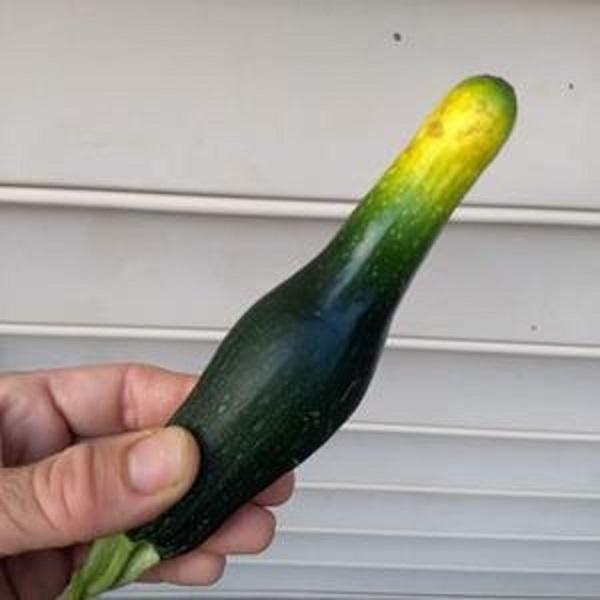
- Symptoms: Flowers or small fruits drop off plants. Squash fruits appear underdeveloped or deformed on one end; small fruits fall off the plant.
- This symptom is typically the result of poor pollination between male and female flowers. This can be caused by weather conditions (too rainy, too cool for bees to pollinate), excessively high temperatures (injuring flowers, reducing or killing pollen), and/or pesticide use (killing bees).
Oddly-shaped fruits / Not true to type
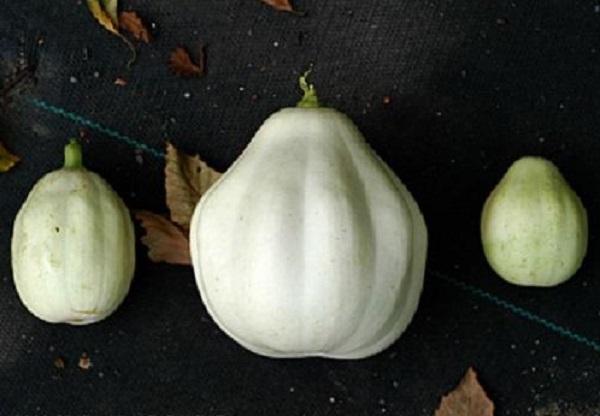
- Symptoms: Squash fruits appear unusual in shape; they do not appear to match the mother plant from which seeds were taken.
- This can occur if the squash was planted from seeds saved from hybrid (F1) cultivars or from non-hybrid cultivars that cross-pollinated in the garden.
Table: Problems of garden squash
This table includes the most common problems of summer and winter squash described above, as well as minor, occasional problems of lesser significance.
| Symptoms on Leaves | Details | Possible Causes | Frequency |
|---|---|---|---|
| White powdery spots | May be on upper and lower surfaces of leaves | Powdery mildew | Very common |
| Yellow or tan angular spots | Downy, grayish spots on leaf undersides | Common | |
| Small yellow or white spots (“stippling”) | Leaves eventually turn yellow and look tattered | Squash bugs | Common |
| Smooth gray or silver blotches | No powdery substance or fungal residue | Normal leaf variation | Common |
| Distorted leaves, irregular yellow (mosaic) markings | Leaves may be deformed, puckered or stretched; they may curl upward or downward | Viruses | Occasional |
| Bright yellow leaves | A few leaves turn yellow on healthy plants | ‘B’ gene (precocious yellow gene) | Occasional |
| Wilted leaves and vines | A hole may be present near the base of the stem; with sawdust-like material (frass) | Squash vine borer | Very common |
| Wilted leaves and vines | Leaves recover at night but wilt again and eventually die | Bacterial wilt | Common |
| Chewing/etching of leaves | Chewed leaf tissue is between the leaf veins; visible on the underside of leaves | Occasional | |
| Chewed leaves | Chewed leaves | Cucumber beetles | Very common |
| Symptoms on Fruits | Details | Possible Causes | Frequency |
| Dark, leathery, sunken spot on one end of the fruit | The spot may enlarge until the entire bottom of the fruit becomes dark and shrunken | Blossom end rot | Common |
| Fuzzy gray fungal growth on old flowers and developing fruit | Affected fruit parts turn dark brown and become fuzzy and mushy | Choanephora rot | Common |
| Flower/fruit drop; one end of fruit is underdeveloped or deformed | Affected small fruits fall off the plant | Pollination problems | Occasional |
| Fruits are unusual in shape | Fruits do not resemble the mother plant from which seeds were taken | Not true to type | Occasional |
Compiled by Christa Carignan, Horticulturist & Coordinator, Home & Garden Information Center, University of Maryland Extension. Reviewed by Jon Traunfeld, Extension Specialist, Vegetables/Fruits, University of Maryland Extension
Still have a question? Contact us at Ask Extension.